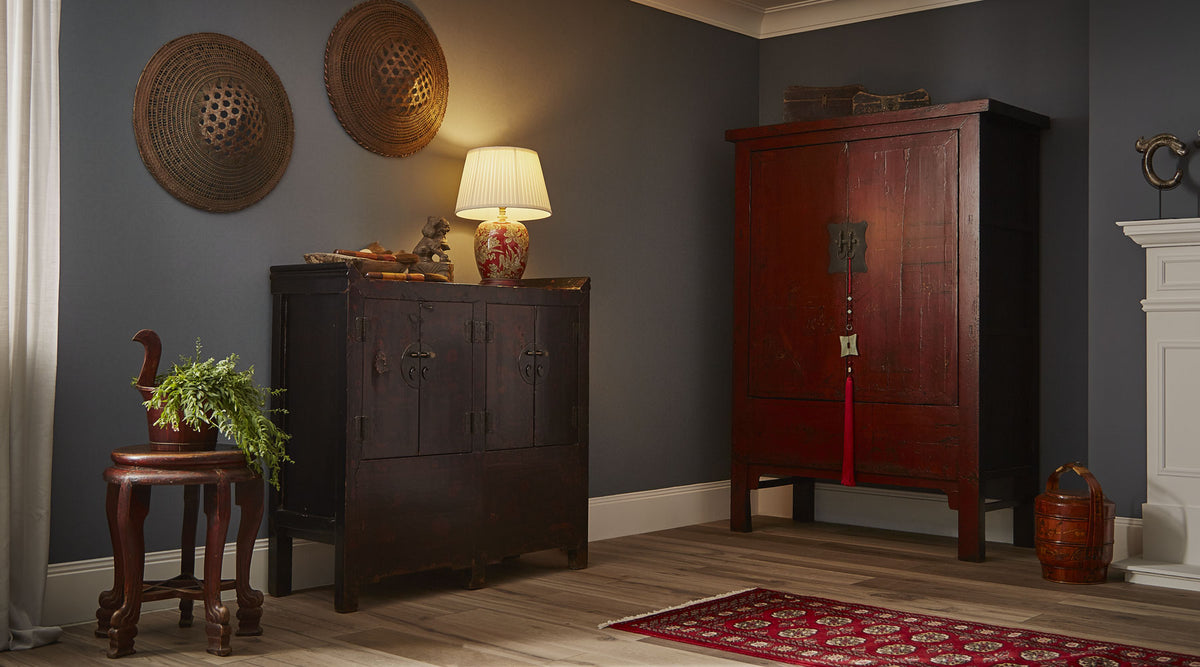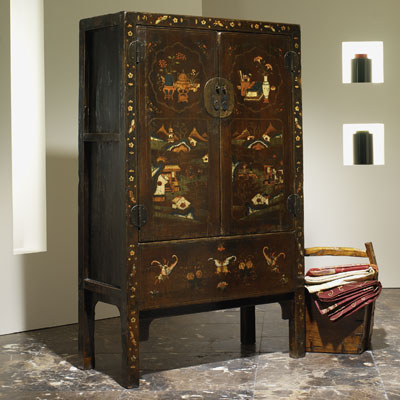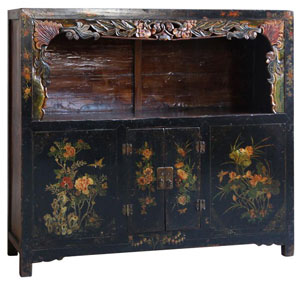
Chinese Furniture - a Guide to Regional Styles
Chinese furniture developed independently from western furniture, with higher level chairs, tables and cabinets developing from an earlier low level, mat culture that was still seen in Japan and other parts of Asia much later. Although construction methods and forms were repeated througout China, local variations in materials and resources, cultures and preferences meant that distinctive regional styles of furniture also developed.
With designs changing little over hundreds of years, it is often easy to identify the origin of many antique pieces, with certain features or decorative elements giving a good indication of the region where they were made. The Chinese antique furniture that is commonly available today tends to come from a fairly small number of provinces. Below we've outlined most of these, along with some of the typical features associated with furniture from each area.
Shandong
Furniture from Shandong province, south of Beijing, was made to withstand the harsh climate of the area, with its hot, humid summers and cold winters. It was therefore normally made with thick, robust frames. The style was quite plain, without the sophisticated detail or decorative styles of central China. Furniture was normally made from northern elm (‘yumu’) as this was readily available, and was often covered with natural tree lacquer. Larger cabinets were normally made with an extended top, with either square or rounded edges, and the tapered ‘round cornered cabinet’ was a common design. Stools and chairs were produced with rounded legs rather than squared, which was more usual for other parts of China.
Shanxi
Shanxi province is located in central China and it is the pieces produced here during the Qing Dynasty that are considered to be the most finely crafted. Cut off from the surrounding regions by mountains, Shanxi was less influenced by other, newer styles, and so many of the pieces produced even up to the early 20th century still showed the same designs and clean lines as furniture from the much earlier Ming Dynasty. Much of the antique Chinese furniture seen today originates from Shanxi, partly because it is considered to be amongst the finest produced, but also because the furniture itself survived better than pieces from other parts of China. There are a number of significant reasons for this. Firstly, because of its isolation, Shanxi was not as badly affected by the social upheaval and chaos of the Cultural Revolution as other areas. While hundreds of thousands of antiques were being destroyed elsewhere in the struggle against the ‘bourgeois’ past, many pieces from Shanxi remained untouched.
Much of the antique Chinese furniture seen today originates from Shanxi, partly because it is considered to be amongst the finest produced, but also because the furniture itself survived better than pieces from other parts of China. There are a number of significant reasons for this. Firstly, because of its isolation, Shanxi was not as badly affected by the social upheaval and chaos of the Cultural Revolution as other areas. While hundreds of thousands of antiques were being destroyed elsewhere in the struggle against the ‘bourgeois’ past, many pieces from Shanxi remained untouched.
Secondly, Shanxi is a region rich in natural resources, particularly coal. Again, this meant that, while the Chinese in other provinces would literally burn their furniture in order to keep warm or to fuel back yard steel furnaces during the ‘Great Leap Forward’, this was rarely necessary in Shanxi. Lastly, the preservation of the wood was considered important to the Shanxi furniture maker. Techniques such as applying a layer of cloth or clay over the top to bind the joints before applying lacquer helped to preserve the material and meant that furniture remained in good condition over generations.
There are a number of styles of furniture that Shanxi is particularly famous for. Foremost of these are the large red or black lacquer cabinets that many people associate with Chinese furniture and which would be given as part of a wedding dowry, such as the one shown above. Although sometimes left plain, the front surfaces of these pieces would very often be decorated with paintings of flora or fauna, landscapes, family antiques or scenes from Chinese legend. Different styles of decoration were associated with different areas, with cities such as Pingyao, Houma and Linfen being important centres for furniture making.
In addition to these larger cabinets, Shanxi is also well known for carved coffers, smaller painted cabinets, and 'double chests’ – a type of cabinet similar in size to a modern-day sideboard, with two sets of doors. Again, these pieces would normally be finished in either red or black lacquer and decorated. The city of Datong in the north of Shanxi was well known for a particular type of deep sided cabinet, made with heavy, thick frames and hardware more similar to furniture from north eastern China.

Shaanxi
Shaanxi province is located north of Shanxi in central China. It incorporates the ancient capital of China, the city of Xian, and is home to the famous terracotta warriors. Perhaps because of its importance as the ancient capital and cultural centre furniture from Shaanxi is traditionally more ornate and artistic than pieces from surrounding regions. In particular, pieces tended to have heavy carving and ornamental ironwork. Coffers and coffer tables with high relief carving around the drawers, such as the one shown right, are particularly common pieces from the region, usually with secret compartments below the drawers designed to store valuables.
Gansu
Gansu is a large province situated in northwest China. There are two distinctive styles of furniture that were produced in the region. The first of these was common in the eastern part of Gansu, and is very similar in style to neighbouring inner Mongolian furniture. These pieces include trunks and simple storage chests often made from fir or pine wood coloured in bold lacquers and decorated with bright paintings. A particular style often seen on the market today is a cabinet converted for modern use from a grain chest. These pieces were once used to store rice or grain and would be opened from lids at the top. They are almost always now converted to have front opening doors to make them more practical as modern day sideboards. The front of these pieces, often repainted, usually shows vases or flowers set against a white background within a red and black lacquer frame.
Furniture from the western part of Gansu is very different in style. Here a plainer style was popular and, being readily available in the area, walnut was the main material used for furniture making. Pieces tended to be solid and sturdy in construction, with typical items being simple cabinets with minimal decoration other than round brassware on the doors. One very distinctive feature of the cabinets produced in the region are the curved, protruding feet, like mini cabriole legs, that are seen particularly on pairs of low cabinets and on large, wide cabinets used to store clothing. Altar tables and painting tables were also quite different in design from similar pieces in the rest of China, having round corner legs and a simple, almost contemporary look which makes them ideal for blending into a modern setting.
Qinghai
Furniture from the remote province of Qinghai in far western China is quite similar in style to some of the painted furniture from nearby Gansu. Large, wide cabinets  with doors at the bottom and shelf space above (as shown here) are particular to the region, but are often cut down by workshops in China to remove the upper shelf, leaving only a sideboard sized cabinet that is more practical for a modern day home. Typically, Qinghai cabinet doors would be small and set centrally with a panel either side. This made it more difficult to access the furthest parts of the inside of the cabinet, supposedly acting as a deterrent to would be thieves. In a nod to modern day practicality, the panels either side of these doors are often reset by antique restorers in China so that they too can be opened.
with doors at the bottom and shelf space above (as shown here) are particular to the region, but are often cut down by workshops in China to remove the upper shelf, leaving only a sideboard sized cabinet that is more practical for a modern day home. Typically, Qinghai cabinet doors would be small and set centrally with a panel either side. This made it more difficult to access the furthest parts of the inside of the cabinet, supposedly acting as a deterrent to would be thieves. In a nod to modern day practicality, the panels either side of these doors are often reset by antique restorers in China so that they too can be opened.
Beautifully painted blanket chests are also popular pieces from Qinghai. These are usually decorated with paintings of family valuables such as vases and other antiques, denoting the owner’s wealth and status. They were often given as part of a wedding dowry, along with the clothes and other items they held inside. Other popular decorative themes therefore include symbols of marital happiness such as butterflies, as well as inscriptions wishing a joyful and prosperous marriage to the bride and groom.
Mongolia
In Inner Mongolia most furniture was constructed from pine, as this was more abundant than the elm used in other parts of China. Many pieces were brightly painted, with common themes being not only flowers or family valuables, but also animals. The paintings are normally quite similar to those seen on Tibetan furniture, but differ in the colours used. Mongolian furniture was normally painted in just three colours – usually yellow, green and red, while Tibetan furniture tends to show a more expansive pallet of colours. Common pieces from Mongolia include grain chests, usually converted to have front opening doors for modern practicality in place of the top lids, and smaller painted cabinets.
Tibet
Because there was virtually no consumer class in Tibet during the 19th century to demand luxury goods such as fine furniture, almost all furniture from the region originated in the monasteries, made by and for the monks. Apprentice monks would usually be given the task of producing furniture, and this use of a largely unskilled workforce meant that the resulting pieces were often quite crude.
Tibetan furniture is usually made from pine – the most readily available material, and the pieces have a very distinctive style, being brightly painted with designs usually including flowers or religious imagery. The paintings were produced using natural pigments which tend to fade over time and common colours include yellow, green, red, blue, orange and black. Tibetan furniture in its original state, without any retouching to the paintings, is now becoming quite rare and as a result these pieces are becoming more and more expensive.
Fujian
Fujian is located along the south east coast of China, an area more liable to flooding than other regions. Because of this furniture from Fujian was usually made with slightly longer legs in order to withstand damp floors or flooding. Pieces were often decorated with ornate carvings and constructed from more than one type of wood. For example, the frame of a cabinet may be made from fir or pine, while inset panels would be made from camphor – a wood more easy to carve. Most furniture would be finished in either red or black lacquer, often with gilt paintings on the surfaces.
Zhejiang
Most of the furniture produced in Zhejiang on China’s east coast was made from fir, a wood that is liable to crack if moved to a less humid climate and less robust than elm. As a result few pieces more than 200 years old can be seen today. Zhejiang furniture is quite decorative, particularly with relief carvings on the front of cabinets, drawers and tables. A particular design from the city of Ningbo was the ‘kitchen cabinet’ – a large cabinet with either lattice work or wooden (sometimes bamboo) strips in the doors to allow ventilation. These pieces were often used to store food and cooking utensils, hence the name, but were also used for more general storage.
Anhui
Furniture from Anhui in eastern China, is particularly delicate in style, often with beautiful carvings. Fir was the most common material used, but pine, cypress and elm were also used. Carvings were often of flowers and animals, as well as scenes of people. While some pieces show the natural grain of the wood, others were finished particularly in red lacquer. Anhui is particularly well known for its wonderfully carved door and window panels, which were often exquisitely carved from camphor wood. These pieces were almost always carved from one piece of wood rather than being made by joining many pieces together.
Xinjiang
Xinjiang is a large province located to the far northwest of China, once an important stop on the silk route through to central Asia and beyond. It borders Kyrgyzstan, Tajikistan and Pakistan to the West, Mongolia to the northeast and Tibet to the south. Conquered by the Chinese in the Qing dynasty, the region continues to be home to a large muslim population, including primarily the Uyghurs. The central Asian influences are easy to see in the furniture produced in Xinjiang. In particular, large traditional wooden daybeds were brightly painted and decorated with ornate carvings in geometric patterns reminiscent of Moorish furniture. Many of these old beds end up being reduced in depth with doors added from the carved panels, sold as more practical sideboards. The cabinet in the image below is a typical example.






Leave a comment